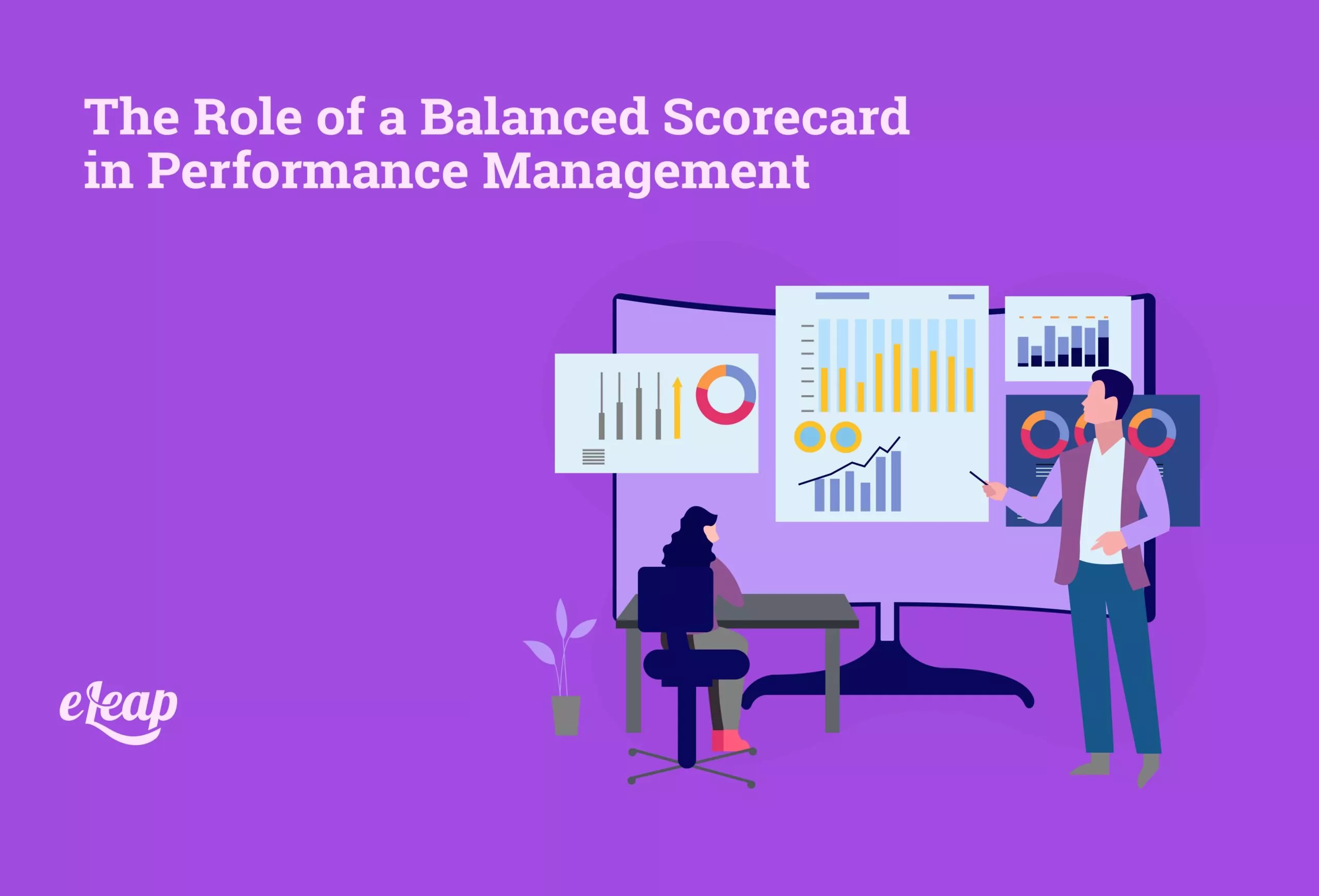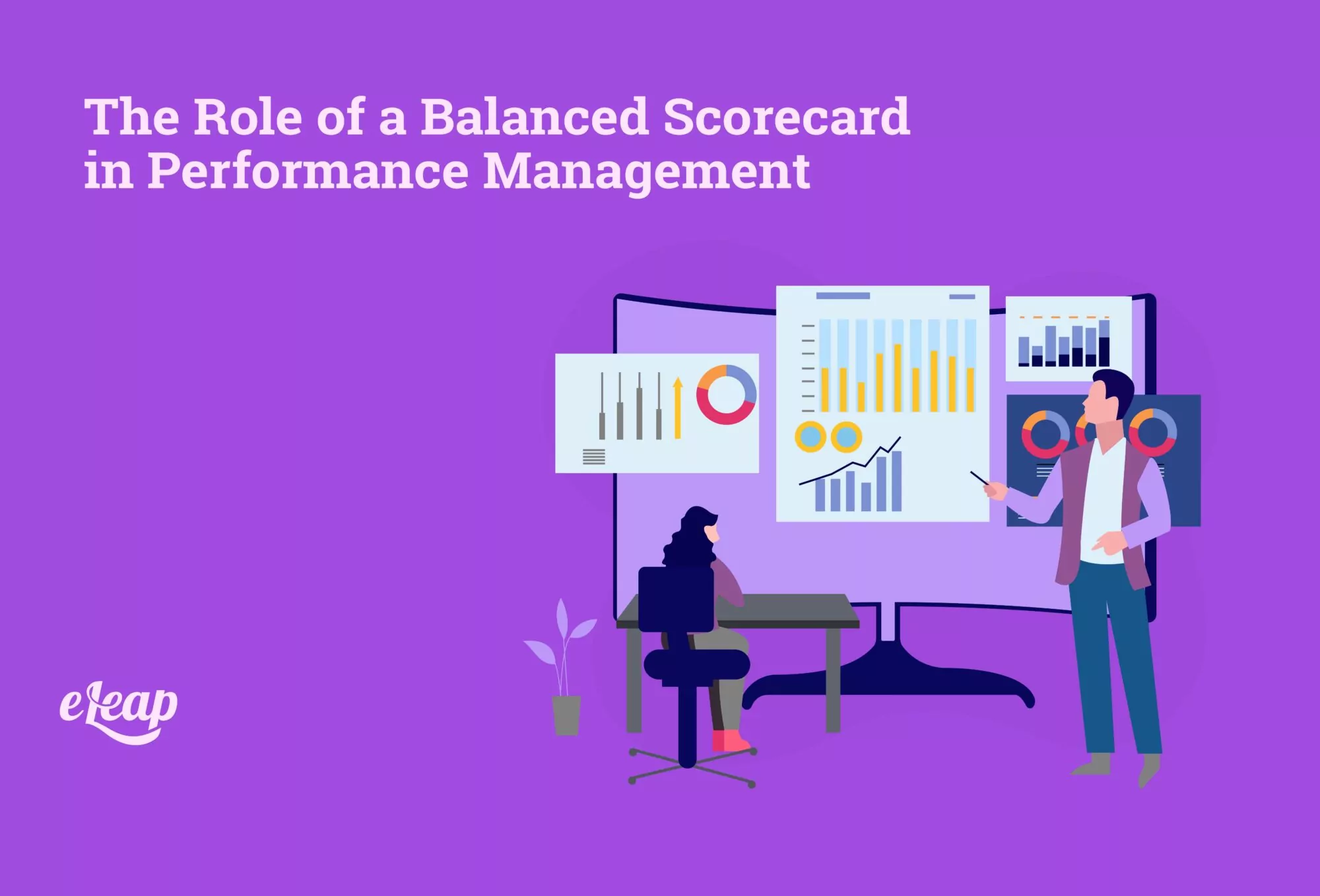The Role of a Balanced Scorecard in Performance Management

Performance management is critical for any organization striving to meet its long-term strategic goals. In this context, the Balanced Scorecard (BSC) plays a pivotal role by enabling businesses to monitor and improve their performance across multiple dimensions, ensuring that short-term actions align with long-term objectives. This article explores the role of the Balanced Scorecard in performance management, delving into its structure, benefits, and implementation strategies. See how eLeaP®’s Performance Management Platform helps you apply these insights to drive better results.
What is the Balanced Scorecard?
The Balanced Scorecard (BSC) is a strategic management framework that comprehensively assesses organizational performance. Developed by Dr. Robert Kaplan and Dr. David Norton in the early 1990s, BSC offered organizations a more balanced way of measuring success, moving beyond financial metrics to include non-financial perspectives that affect long-term performance.
The Origins and Evolution of the Balanced Scorecard
The Balanced Scorecard was born out of a need for organizations to gain a holistic view of their performance. Traditional management systems focus primarily on financial metrics, such as profit margins and return on investment. While these indicators are important, they fail to capture the broader elements influencing long-term success, such as customer satisfaction, employee engagement, and innovation.
Kaplan and Norton recognized the limitations of financial-only performance management and introduced the Balanced Scorecard to incorporate multiple dimensions into a performance management system. Over time, the BSC framework evolved, expanding its influence across various industries and becoming a widely recognized tool for strategic performance measurement.
The Four Perspectives of the Balanced Scorecard
The Balanced Scorecard is built around four key perspectives that provide a more comprehensive view of an organization’s performance. These perspectives are:
- Financial Perspective: This perspective focuses on the economic outcomes that result from the organization’s actions. Metrics include profitability, cost efficiency, revenue growth, and shareholder value. While financial metrics are essential, the BSC framework encourages businesses to balance these with other key performance drivers.
- Customer Perspective: Customer satisfaction, retention, and loyalty are critical to any business. This perspective assesses how well the organization serves its customers and whether it meets their expectations. Metrics include customer satisfaction scores, net promoter scores (NPS), and market share.
- Internal Process Perspective: This perspective examines internal operations’ efficiency and effectiveness. It measures how healthy processes are running and how the organization can improve them to deliver better value to customers and stakeholders. Standard metrics include process cycle times, quality control measures, and innovation rates.
- The learning and Growth Perspective focuses on an organization’s ability to innovate, improve, and grow. It measures employee engagement, training effectiveness, knowledge management, and leadership development. This perspective acknowledges that an organization’s long-term success depends on its ability to adapt and improve continuously.
The Key Advantages of Implementing a Balanced Scorecard
Businesses implement the Balanced Scorecard primarily because of its advantages over traditional performance management systems.
Holistic and Balanced Performance Metrics
Traditional performance management systems often focus solely on financial results. While these are undeniably important, they do not depict an organization’s performance entirely. The Balanced Scorecard incorporates financial and non-financial metrics, allowing organizations to assess performance from a broader perspective. This holistic approach ensures that no critical factors, such as customer satisfaction or employee development, are overlooked.
Strategic Alignment Across All Levels of the Organization
One of the balanced scorecard’s key strengths is its ability to align organizational strategy with day-to-day activities. By breaking down strategic objectives into measurable goals, organizations can ensure that all departments, teams, and employees work toward the same outcomes. This alignment drives greater efficiency and helps prevent divergent efforts that might detract from the overall mission.
Facilitating Informed Decision-Making
A primary advantage of the Balanced Scorecard is the real-time data it provides managers, enabling better decision-making. By accessing financial and operational metrics, businesses can identify issues quickly, adjust strategies, and capitalize on new opportunities. For example, if customer satisfaction scores drop, managers can immediately investigate internal processes or employee training programs to address the issue.
The Impact of the Balanced Scorecard on Organizational Performance

The Balanced Scorecard has a profound impact on an organization’s performance. Businesses can drive better results across multiple fronts by fostering a more integrated approach to performance management.
Linking Strategy with Execution
A core function of the Balanced Scorecard is its ability to link an organization’s high-level strategy to operational execution. Through the BSC, strategic goals are broken down into specific, measurable actions across the four perspectives. This process ensures that strategy is not just a set of abstract ideas but actionable, quantifiable objectives to which everyone in the organization can contribute.
The Balanced Scorecard also gives managers a clear framework for communicating strategy throughout the organization. This process helps employees understand how their work directly impacts the company’s success.
Enhancing Long-Term Sustainable Growth
The Balanced Scorecard encourages organizations to pursue long-term growth rather than short-term gains by focusing on financial and non-financial metrics. This balanced focus helps ensure that a business does not neglect critical areas such as employee development or customer satisfaction in favor of immediate profit. For example, a company may invest in employee training and development, knowing it will increase productivity and innovation over the long term.
Fostering Accountability and Transparency Across Departments
The Balanced Scorecard fosters greater department accountability by clearly defining roles, responsibilities, and performance expectations. It enables employees at all levels to understand how their actions contribute to organizational goals, creating a sense of ownership over their performance. This clarity and transparency lead to a stronger, more cohesive work culture.
Step-by-Step Guide to Implementing a Balanced Scorecard
For organizations looking to implement the Balanced Scorecard, a proven framework guides the process from start to finish. The following steps outline the critical phases of BSC implementation.
Defining Strategic Objectives and Vision
The first step in implementing a Balanced Scorecard is clearly defining the organization’s strategic vision and objectives. These should align with the broader goals of the business and be broken down into specific, measurable actions for each of the four perspectives. For instance, a company’s vision might be to “become the industry leader in customer satisfaction.” This stage could then translate into specific objectives, such as improving product quality (internal process perspective) or reducing response time to customer inquiries (customer perspective).
Identifying Key Performance Indicators (KPIs)
Once the strategic objectives are defined, the next step is identifying the KPIs to measure progress toward these goals. KPIs should be tailored to the organization’s unique needs and the specific objectives within each perspective. For example, from a financial standpoint, KPIs include return on investment (ROI) or revenue growth, while customer satisfaction can be measured using NPS scores.
Designing a Strategy Map for Clarity
The strategy map visually represents the organization’s strategy and how each perspective contributes to overall success. A well-designed strategy map helps to communicate the organization’s objectives to all employees and shows the cause-and-effect relationships between different goals. It enables businesses to see how improvements in one area (e.g., employee training) can lead to better performance in others (e.g., customer satisfaction).
Continuous Monitoring and Feedback Mechanisms
The Balanced Scorecard is not a one-time project; it requires continuous monitoring and adjustment. As business conditions change, objectives and KPIs must be reviewed and updated. Regular performance reviews, feedback loops, and data analysis allow organizations to make real-time adjustments, ensuring that strategies remain aligned with the company’s goals.
Real-Life Examples of Balanced Scorecard Implementation
The effectiveness of the Balanced Scorecard is evident in many organizations worldwide. Let’s examine how some businesses successfully implement the BSC to drive performance.
Case Study: A Tech Company Optimizing Innovation
A leading technology company used the Balanced Scorecard to align its innovation efforts with its overall strategy. The company could streamline its product development cycles and improve customer satisfaction by setting clear KPIs related to research and development, customer feedback, and internal processes. The Balanced Scorecard helped them track real-time performance, enabling faster decision-making and better alignment between departments.
Case Study: A Healthcare Organization Enhancing Patient Care
A primary healthcare provider adopted the Balanced Scorecard to improve patient care and operational efficiency. The organization enhanced patient outcomes by integrating customer satisfaction metrics with internal process improvements while reducing operational costs. The BSC framework provided the necessary structure to align healthcare services with organizational goals, ultimately leading to better patient experiences and more efficient hospital management.
Case Study: A Manufacturing Company Driving Operational Excellence
A global manufacturing company used the Balanced Scorecard to improve production processes and reduce costs. By focusing on internal process improvements, such as reducing cycle times and increasing quality control, they were able to increase throughput and improve profitability. Additionally, by tracking employee development from the learning and growth perspective, the company ensured its workforce was continuously enhanced.
Conclusion
The Balanced Scorecard is a powerful tool for performance management. It offers organizations a comprehensive framework to align strategy with execution, track progress across multiple dimensions, and drive sustainable growth. By focusing on financial and non-financial metrics, the Balanced Scorecard ensures that all aspects of an organization’s performance are considered, creating a more holistic view of success. When implemented correctly, the Balanced Scorecard can transform performance management, fostering a culture of continuous improvement and helping organizations achieve their long-term goals.
For organizations like eLeaP, which focuses on strategic development and employee training, the Balanced Scorecard is an invaluable tool for measuring both the effectiveness of internal processes and the impact of employee growth on organizational performance.